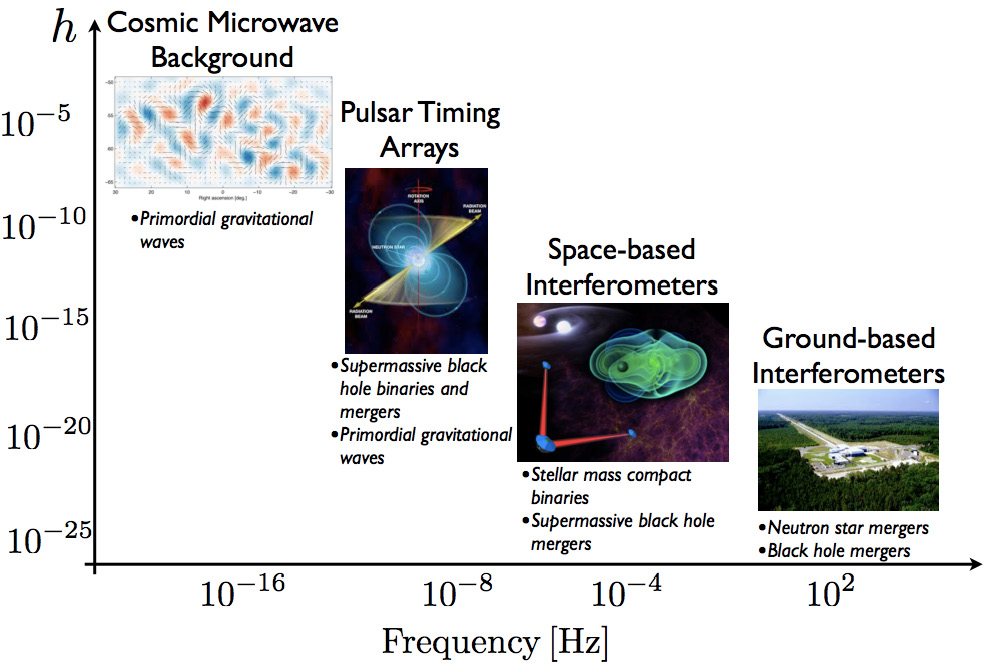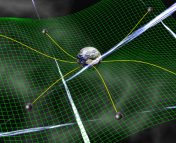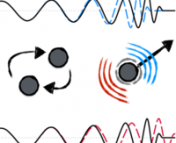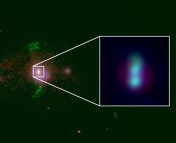Title: The NANOGrav 12.5 yr Data Set: Search for an Isotropic Stochastic Gravitational-wave Background
Authors: The NANOGrav collaboration
Corresponding Author: J. Simon
Status: Published in The Astrophysical Journal Letters [closed access], available on Arxiv
In the past decade, astronomers successfully unlocked a whole new way of studying the universe by listening to gravitational waves – faint ripples in the fabric of space and time caused by the motion of massive objects. The first gravitational wave signals that the LIGO and Virgo detectors heard were from merging pairs of neutron stars and stellar-mass black holes. These waves have frequencies within the audible range of humans, and hence can be converted into audio. Being very short-duration, they sound like plucked notes of a violin. Now, the North American Nanohertz Observatory for Gravitational Waves (NANOGrav) collaboration, analyzing over a decade of observations, might have recorded the first hints of a low-frequency, background hum in this spacetime symphony.
The Gravitational Wave Background
Just like the wide range of the electromagnetic spectrum from radio waves to gamma rays, gravitational waves also form a spectrum (Figure 1) where different frequencies of gravitational waves are emitted from different kinds of sources. Ground-based detectors like LIGO-Virgo detect individual events involving a pair of black holes or neutron stars spiralling into each other at a rate of hundred to a thousand revolutions per second before colliding. This corresponds to a frequency of gravitational wave radiation in the 10-1000 Hz range that LIGO-Virgo are tuned into. In this range, each event lasts for less than a minute.

In contrast, gravitational wave rumbles from much lower frequencies are expected to come from mergers involving supermassive black holes. These gargantuan objects, with masses more than a million times the mass of the Sun, emit detectable gravitational radiation even when they’re well separated and revolving around each other over a period of more than a year. This means their frequency of emission lies in the nanohertz (nHz.) range, giving NANOGrav its name. Instead of detecting individual mergers, the low-frequency spectrum is expected to be dominated by the collective background hum of a population of supermassive black hole pairs, or binaries; think of a hundred cellos drawing different notes simultaneously, as opposed to the plucking of a few lone violin strings. This is called the stochastic gravitational wave background.
NANOGrav: a galaxy-sized gravitational wave detector
In order to hear the gravitational-wave background, NANOGrav keeps its eyes on an array of Millisecond Pulsars (MSPs) spread throughout the galaxy. MSPs are compact neutron stars, and lead paper author Joe Simon analogizes them to, “[objects] with a little over the Sun’s mass of matter squeezed into the downtown area of a city, and spinning as fast as a kitchen blender.” Being pulsars, they emit pulses of radiation with extraordinary punctuality in the millisecond timescale, which NANOGrav has kept track of using the Green Bank telescope and the Arecibo observatory. Each of the 45 pulsars acts like a probe for gravitational wave detection, which makes NANOGrav almost a galaxy-sized detector!
Assuming the center of mass of our Solar System, also known as the barycenter, is a fixed reference point in the array of 45 pulsars, the time(s) at which their pulses arrive there with respect to each other can be known with great accuracy. The only thing that can perturb this regularity is a passing gravitational wave, which displaces the barycenter like a floating duck, but ever-so-slightly. This leads to the pulses arriving sooner from the pulsars towards which we are displaced, and vice versa. Remember that these displacements are extremely tiny and a result of a gravitational wave background. Hence to make a detection, we need to observe and correlate the pulse arrival times from a set of pulsars spread across all angles and over a large amount of time. With enough data, we expect so see a characteristic pattern of correlation in the timing of two pulsars based on the angle they form with the barycenter, known as the ‘Hellings and Downs curve’ (Figure 2)
What the 12.5 year dataset reveals…

Since their first observations starting with 12 pulsars from 2005, NANOGrav has published upper bounds as to how strong the gravitational wave background could be while still escaping our detection. Their latest set of results comprises the most number of pulsars (45) being tracked for the longest time duration of 12.5 years. They reveal, for the first time, a possible signal at very low frequencies achieved by the long observing time (10 years of observation correspond to 1/10 yr-1 or 1 nHz.) Hints of a pattern following the Hellings and Downs curve can also be seen in the angular distribution of correlated pulsar arrival times in the new dataset (Figure 2). Simulations reveal that if this is indeed a signature of gravitational wave background, future observations will show increasing evidence for these correlations.
This excess power at low frequencies is still not enough to definitively claim a detection of gravitational wave background. However, to ensure that there is no evidence against it, many alternative sources of noise have been ruled out by NANOGrav. In addition, significant upgrades have been made to their timing models as well as measuring the barycenter location with greater accuracy using data from new solar system spacecraft like Juno. All of this puts the field in a tantalizing position where it is only a matter of time before the right chords are struck to reveal the background. Knowing this will unearth a wealth of knowledge about the underlying populations of supermassive black holes.
Astrobite edited by John Weaver
Featured image credit: Tonia Klein / NANOGrav




